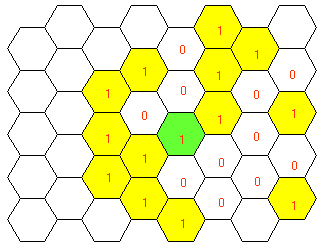
Researchers have expended a great deal of effort computing as many of those digits as computer technology and mathematical methods allow. Last year, Yasumasa Kanada of the University of Tokyo calculated pi to 206,158,430,000 decimal digits.
A high school student has now smashed that record. Using a home-built computer crafted from scrounged parts, Franklin Oliver O’Leary of Deep Orange, N.J., has calculated 500 billion decimal digits of pi, starting at the trillionth digit. His heroic effort has opened up a vast, untrodden realm for alphanumerical investigation.
O’Leary’s initial forays into this digital wilderness have already produced astonishing results, especially when letters of the English alphabet are substituted for the digits of pi.
For instance, the initial digits of pi can be grouped as follows: 3. 14 15 9 26 5. Using the substitution 1 = A, 2 = B, and so on, you get C.NOIZE. In other words, you SEE NOISE when you look at the apparently random decimal digits of pi.
O’Leary didn’t let that result fool him, however. It was simply one of nature’s defense mechanisms to mislead and deflect the casual investigator, he decided.
Following the lead of prominent logologician Mike Keith of Salem, Ore., O’Leary converted the higher decimal digits of pi from base 10 to base 26. He then identified the 26 different base-26 digits with letters of the English alphabet: 0 = A, 1 = B, 2 = C,. . ., 25 = Z.
Here are the first 100 digits of pi expressed in this way:
D.DRSQLOLYRTRODNLHNQTGKUDQGTUIRXNEQBCKBSZIVQQ
VGDMELMUEXROIQIYALVUZVEBMIJPQQXLKPLRNCFWJPBYM
GGOHJMMQISMS. . . .
In effect, “pi in base 26 emulates the mythical army of typing monkeys spewing out random letters,” Keith says. “This implies that any text, no matter how long, should eventually appear in the base-26 digits of pi.”
The first one-letter word, O, occurs at position 6 (after the decimal point). A two-letter word, LO, first appears at position 5; a three-letter word, ROD, at position 11; a four-letter word, TROD, at position 10; a five-letter word, STEEL, at position 6,570; a six-letter word, OXYGEN, at position 11,582; and a seven-letter word, SUBPLOT, at position 115,042.
“The fact that OXYGEN is the first six-letter word obviously indicates that pi is truly the very stuff of life,” gushes famed numerologist April F. Day of Banana Slug University.
Of course, you can also search for words that appear as consecutive letters running backward (O, OR, TRY, FILM, FILMY, FLOUTS, ALPHORN) or as consecutive letters running forward, backward, up, down, and diagonally when the letters are organized into rectangular arrays. The possibilities are endless, the patterns intriguing, and the implications profound.
O’Leary discovered that the higher digits of pi are a rich repository of vital information. Interpreted in the right way, cryptic sentences, phrases, and words can be strung together and used to predict the future.
What really caught O’Leary’s attention was a curious sequence of letters that could be broken up into stock-ticker symbols for companies listed on the NASDAQ stock exchange. No one knows in detail what O’Leary did with that tantalizing hint, but one of his friends has suggested that O’Leary missed the deadline for submitting his entry in the Intel Science Talent Search because he was busy day trading and tracking his stock-market investments.
O’Leary has also examined the higher binary digits of pi. In binary form, pi has the value 11.0010010000111111011010101000100010000101101000110000
100011010001100010011. . . .
Writing the binary digits in order on a hexagonal grid, spiraling out from the starting cell, then coloring in every cell containing 1, generates an image after a sufficiently large number of revolutions along the spiral. Some observers have interpreted that image to be a face–possibly the portrait of a lady.
O’Leary’s investigations of spirals among the higher binary digits of pi also suggest a face. “It’s the profile of the next President of the United States,” O’Leary claims. However, so as not to unduly influence the upcoming election, he has decided not to reveal the image or its identity until after the results are in.
“There’s much more to come,” O’Leary predicts. “The digits of pi have a lot to tell us.”






